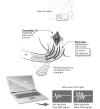Model of Traumatic Spinal Cord Injury for Evaluating Pharmacologic Treatments in Cynomolgus Macaques (Macaca fasicularis)
- PMID: 29460723
- PMCID: PMC5824141
Model of Traumatic Spinal Cord Injury for Evaluating Pharmacologic Treatments in Cynomolgus Macaques (Macaca fasicularis)
Abstract
Here we present the results of experiments involving cynomolgus macaques, in which a model of traumatic spinal cord injury (TSCI) was created by using a balloon catheter inserted into the epidural space. Prior to the creation of the lesion, we inserted an EMG recording device to facilitate measurement of tail movement and muscle activity before and after TSCI. This model is unique in that the impairment is limited to the tail: the subjects do not experience limb weakness, bladder impairment, or bowel dysfunction. In addition, 4 of the 6 subjects received a combination treatment comprising thyrotropin releasing hormone, selenium, and vitamin E after induction of experimental TSCI. The subjects tolerated the implantation of the recording device and did not experience adverse effects due the medications administered. The EMG data were transformed into a metric of volitional tail moment, which appeared to be valid measure of initial impairment and subsequent natural or treatment-related recovery. The histopathologic assessment demonstrated widespread axon loss at the site of injury and areas cephalad and caudad. Histopathology revealed evidence of continuing inflammation, with macrophage activation. The EMG data did not demonstrate evidence of a statistically significant treatment effect.
Figures









Similar articles
-
A Novel Application of Deep Learning (Convolutional Neural Network) for Traumatic Spinal Cord Injury Classification Using Automatically Learned Features of EMG Signal.Sensors (Basel). 2022 Nov 3;22(21):8455. doi: 10.3390/s22218455. Sensors (Basel). 2022. PMID: 36366153 Free PMC article.
-
Neurophysiological Characterization of a Non-Human Primate Model of Traumatic Spinal Cord Injury Utilizing Fine-Wire EMG Electrodes.Sensors (Basel). 2019 Jul 27;19(15):3303. doi: 10.3390/s19153303. Sensors (Basel). 2019. PMID: 31357572 Free PMC article.
-
A Speculative Pharmaceutical Cocktail to Treat Spinal Cord Injury.Am J Phys Med Rehabil. 2016 Jul;95(7):e108-10. doi: 10.1097/PHM.0000000000000486. Am J Phys Med Rehabil. 2016. PMID: 27088464 No abstract available.
-
Opiate-receptor antagonists, thyrotropin-releasing hormone (TRH), and TRH analogs in the treatment of spinal cord injury.Cent Nerv Syst Trauma. 1987;4(4):217-26. doi: 10.1089/cns.1987.4.217. Cent Nerv Syst Trauma. 1987. PMID: 3128405 Review. No abstract available.
-
Effect of vitamins C and E on recovery of motor function after spinal cord injury: systematic review and meta-analysis of animal studies.Nutr Rev. 2020 Jun 1;78(6):465-473. doi: 10.1093/nutrit/nuz076. Nutr Rev. 2020. PMID: 31800057
Cited by
-
A Novel Application of Deep Learning (Convolutional Neural Network) for Traumatic Spinal Cord Injury Classification Using Automatically Learned Features of EMG Signal.Sensors (Basel). 2022 Nov 3;22(21):8455. doi: 10.3390/s22218455. Sensors (Basel). 2022. PMID: 36366153 Free PMC article.
-
Neurophysiological Characterization of a Non-Human Primate Model of Traumatic Spinal Cord Injury Utilizing Fine-Wire EMG Electrodes.Sensors (Basel). 2019 Jul 27;19(15):3303. doi: 10.3390/s19153303. Sensors (Basel). 2019. PMID: 31357572 Free PMC article.
-
Translational Regenerative Therapies for Chronic Spinal Cord Injury.Int J Mol Sci. 2018 Jun 15;19(6):1776. doi: 10.3390/ijms19061776. Int J Mol Sci. 2018. PMID: 29914060 Free PMC article. Review.
-
Using Nutraceuticals to Help Manage Traumatic Spinal Cord Injury.Pharmaceuticals (Basel). 2024 Jan 4;17(1):71. doi: 10.3390/ph17010071. Pharmaceuticals (Basel). 2024. PMID: 38256904 Free PMC article.
References
-
- Algotar AM, Stratton MS, Ahmann FR, Ranger-Moore J, Nagle RB, Thompson PA, Slate E, Hsu CH, Dalkin BL, Sindhwani P, Holmes MA, Tuckey JA, Graham DL, Parnes HL, Clark LC, Stratton SP. 2012. Phase 3 clinical trial investigating the effect of selenium supplementation in men at high-risk for prostate cancer. Prostate 75:328–335. - PMC - PubMed
-
- Allen AR. 1911. Surgery of experimental lesion of spinal cord equivalent to crush injury of fracture dislocation of spinal column. JAMA LVII:878–880.
-
- Anderson DK, Saunders RD, Demediuk P, Dugan LL, Braughler JM, Hall ED, Means ED, Horrocks LA. 1985. Lipid hydrolysis and peroxidation in injured spinal cord: partial protection with methylprednisolone or vitamin E and selenium. Cent Nerv Syst Trauma 2:257–267. - PubMed
-
- Beattie MS, Bresnahan JC, Komon J, Tovar CA, VanMeter M, Anderson DK, Faden AL, Hsu CY, Noble LJ, Salzman S, Young W. 1997. Endogenous repair after spinal cord contusion injuries in the rat. Exp Neurol 148:453–463. - PubMed
-
- Brown TG. 1911. The intrinsic factors in the act of progression in the mammal. Proc R Soc Lond B Biol Sci 84:308–319.
Publication types
MeSH terms
Substances
Grants and funding
LinkOut - more resources
Full Text Sources
Medical
